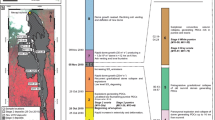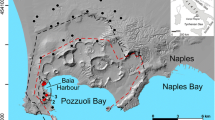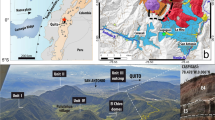Abstract
The Fontana Lapilli deposit was erupted in the late Pleistocene from a vent, or multiple vents, located near Masaya volcano (Nicaragua) and is the product of one of the largest basaltic Plinian eruptions studied so far. This eruption evolved from an initial sequence of fluctuating fountain-like events and moderately explosive pulses to a sustained Plinian episode depositing fall beds of highly vesicular basaltic-andesite scoria (SiO2 > 53 wt%). Samples show unimodal grain size distribution and a moderate sorting that are uniform in time. The juvenile component predominates (> 96 wt%) and consists of vesicular clasts with both sub-angular and fluidal, elongated shapes. We obtain a maximum plume height of 32 km and an associated mass eruption rate of 1.4 × 108 kg s−1 for the Plinian phase. Estimates of erupted volume are strongly sensitive to the technique used for the calculation and to the distribution of field data. Our best estimate for the erupted volume of the majority of the climactic Plinian phase is between 2.9 and 3.8 km3 and was obtained by applying a power-law fitting technique with different integration limits. The estimated eruption duration varies between 4 and 6 h. Marine-core data confirm that the tephra thinning is better fitted by a power-law than by an exponential trend.












Similar content being viewed by others
References
Bice DC (1980) Tephra stratigraphy and physical aspects of recent volcanism near Managua, Nicaragua. PhD thesis, Univerisity of California, Berkeley, p 422
Bice DC (1985) Quaternary volcanic stratigraphy of Managua, Nicaragua: correlation and source assignment for multiple overlapping Plinian deposits. Geol Soc Amer Bull 96:553–566
Bonadonna C (2006) Probabilistic modelling of tephra dispersion. In: Mader HM, Coles SG, Connor CB, Connor LJ (eds) Statistics in volcanology. The Geological Society, London, pp 243–259
Bonadonna C, Ernst GGJ, Sparks RSJ (1998) Thickness variations and volume estimates of tephra fall deposits: the importance of particle Reynolds number. J Volcanol Geotherm Res 81:173–187
Bonadonna C, Houghton BF (2005) Total grainsize distribution and volume of tephra-fall deposits. Bull Volcanol 67:441–456
Carey SN (1997) Influence of convective sedimentation on the formation of widespread tephra fall layers in the deep sea. Geology 25:839–842
Carey SN, Sparks RSJ (1986) Quantitative models of the fallout and dispersal of tephra from volcanic eruption columns. Bull Volcanol 48:109–125
Carey R, Houghton BF, Sable JE, Wilson CJN (2007) Contrasting grain size and componentry in complex proximal deposits of the 1886 Tarawera basaltic Plinian eruption. Bull Volcanol 69:903–926
Chester DK, Dibben CJL, Duncan AM (2002) Volcanic hazard assessment in western Europe. J Volcanol Geotherm Res 115:411–435
Cioni R, Marianelli P, Santacroce R, Sbrana A (1999) Plinian and subplinian eruptions. In: Sigurdsson H, Houghton BF, McNutt S, Rymer H, Stix J (eds) Encyclopedia of volcanoes. Academic, San Diego, pp 477–494
Cioni R, Longo A, Macedonio G, Santacroce R, Sbrana A, Sulpizio R, Andronico D (2003) Assessing pyroclastic fall hazard through field data and numerical simulations: example from Vesuvius. J Geophys Res 108(B2):ECV2.1–ECV2.11
Coltelli M, Del Carlo P, Vezzoli L (1998) Discovery of a Plinian basaltic eruption of Roman age at Etna volcano, Italy. Geology 26:1095–1098
Connor CB, Hill BE, Winfrey B, Franklin NM, La Femina PC (2001) Estimation of volcanic hazards from tephra fallout. Nat Hazards Rev 2:33–42
De Rita D, Giordano G, Esposito A, Fabbri M, Rodani S (2002) Large volume phreatomagmatic ignimbrites from the Colli Albano volcano (Middle Pleistocene, Italy). J Volcanol Geotherm Res 118:77–98
Fierstein J, Hildreth W (1992) The Plinian eruptions of 1912 at Novarupta, Katmai National Park, Alaska. Bull Volcanol 54:646–684
Fierstein J, Natherson M (1992) Another look at the calculation of fallout tephra volumes. Bull Volcanol 54:156–167
Folk RL, Ward WC (1957) Brazon river bar, a study in the significance of grain-size parameters. J Sediment Petrol 27:3–27
Freda C, Gaeta M, Palladino DM, Trigila R (1997) The Villa Senni Eruption (Alban Hills, central Italy): the role of H2O and CO2 on the magma chamber evolution and on the eruptive scenario. J Volcanol Geotherm Res 78:103–120
Freundt A, Kutterolf S, Schmincke HU, Hansteen T, Wehrmann H, Perez W, Strauch W, Navarro M (2006) Volcanic hazards in Nicaragua: Past, present and future. In: Rose WI, Bluth GJS, Carr MJ, Ewert JW, Patino LC, Vallance JW (eds) Volcanic hazards in Central America. Geological Society of America, Special Paper 412, pp 141–165
Girard G, van Wyk de Vries B (2005) The Managua Graben and Las Sierras-Masaya volcanic complex (Nicaragua); pull-apart localization by an intrusive complex: results from analogue modelling. J Volcanol Geotherm Res 144:37–57
Head JW, Wilson L (1989) Basaltic pyroclastic eruptions: influence of gas-release patterns and volume fluxes on fountain structure, and the formation of cinder cones, spatter cones, rootless flows, lava ponds and lava flows. J Volcanol Geotherm Res 37:261–271
Hildreth W, Drake RE (1992) Volcano Quizapu, Chilean Andes. Bull Volcanol 54:93–125
Houghton BF, Smith RT (1993) Recycling of magmatic clasts during explosive eruptions—estimating the true juvenile content of phreatomagmatic volcanic deposits. Bull Volcanol 55:414–420
Houghton BF, Wilson CJN, Del Carlo P, Coltelli M, Sable JE, Carey R (2004) The influence of conduit processes on changes in style of basaltic Plinian eruptions: Tarawera 1886 and Etna 122b.c. J Volcanol Geotherm Res 137:1–14
Inman DL (1952) Measures for describing the size distribution of sediments. J Sediment Petrol 22:125–145
Kutterolf S, Freundt A, Perez W, Wehrmann H, Schmincke HU (2007) Late Pleistocene to Holocene temporal succession and magnitudes of highly-explosive volcanic eruptions in west-central Nicaragua. J Volcanol Geotherm Res 163:55–82
Kutterolf S, Freundt A, Perez T, Morz U, Schacht H, Wehrmann H, Schmincke HU (2008a) Pacific offshore records of Plinian arc volcanism in central America, part 1: along-arc correlations. Geochem Geophys Geosyst 9:Q02S01 doi:10.1029/2007GC001631
Kutterolf S, Freundt A, Perez T (2008b) The Pacific offshore record of Plinian arc volcanism in Central America, part 2: tephra volumes and erupted masses. Geochem Geophys Geosyst 9:Q02S02 doi:10.1029/2007GC001791
La Femina PC, Dixon TH, Strauch W (2002) Bookshelf faulting in Nicaragua. Geology 30:751–754
Marzocchi W, Sandri L, Gasparini P, Newhall C, Boschi E (2004) Quantifying probabilities of volcanic events: the example of volcanic hazard at Mount Vesuvius. J Geophys Res 109:B11201 doi:10.1029/2004JB003155
Paladio-Melosantos ML, Solidum RU, Scott WE, Quiambao RB, Umbal JV, Rodolfo KS, Tubianosa BS, Delos Reyes PJ, Ruelo HR (1996) Tephra falls of the 1991 eruptions of Mount Pinatubo. In: Newhall CG, Punongbaya RS (eds) Fire and mud: eruptions and lahars of Mount Pinatubo, Philippines. Philippine Institute of Volcanology and Seismology, Quezon City, pp 513–535
Palladino DM, Gaeta M, Marra F (2001) A large K-foiditic hydromagmatic eruption from the early activity of the Alban Hills Volcanic District, Italy. Bull Volcanol 63:345–359
Perez W, Freundt A (2006) The youngest highly explosive basaltic eruptions from Masaya Caldera (Nicaragua): stratigraphy and hazard assessment. In: Rose WI, Bluth GJS, Carr MJ, Ewert JW, Patino LC, Vallance JW (eds) Volcanic hazards in Central America. Geological Society of America, Special Paper 412, pp 198–208
Pyle DM (1989) The thickness, volume and grainsize of tephra fall deposits. Bull Volcanol 51:1–15
Pyle DM (1990) New estimates for the volume of the Minoan eruption. In: Hardy DA (ed) Thera and the Aegean world. The Thera Foundation, London, pp 113–121
Sable JE, Houghton BF, Del Carlo P, Coltelli M (2006a) Changing conditions of magma ascent and fragmentation during the Etna 122b.c. basaltic Plinian eruption: evidence from clasts microtextures. J Volcanol Geotherm Res 158:333–354
Sable JE, Houghton BF, Wilson CJN, Carey R (2006b) Complex proximal sedimentation from Plinian plumes: the example of Tarawera 1886 basaltic Plinian eruption. Bull Volcanol 69:89–103
Sarna-Wojcicki AM, Shipley S, Waitt JR, Dzurisin D, Wood SH (1981) Areal distribution thickness, mass, volume, and grain-size of airfall ash from the six major eruptions of 1980. In: Lipman WP, Mullineaux DR (eds) Eruptions of Mount St. Helens, Washington. US Geological Survey Professional Paper Washington, Washington DC, pp 577–600
Scasso R, Corbella H, Tiberi P (1994) Sedimentological analysis of the tephra from 12–15 August 1991 eruption of Hudson Volcano. Bull Volcanol 56:121–132
Self S, Zhao J-X, Holasek RE, Torres RC, King AJ (1996) The atmospheric impact of the 1991 Mount Pinatubo eruption. In: Newhall CG, Punongbaya RS (eds) Fire and mud: eruptions and lahars of Mount Pinatubo, Philippines. Philippine Institute of Volcanology and Seismology, Quezon City, pp 1089–1115
Simkin T, Siebert L (1994) Volcanoes of the world. Geoscience Press Inc., Tucson
Sparks RSJ (1986) The dimensions and dynamics of volcanic eruption columns. Bull Volcanol 48:3–15
Sparks RSJ, Wilson L, Sigurdsson H (1981) The pyroclastic deposits of the 1875 eruption of Askja, Iceland. Philos Trans R Soc Lond 229:241–273
Sulpizio R (2005) Three empirical methods for the calculation of distal volume of tephra-fall deposits. J Volcanol Geotherm Res 145:315–336
Sulpizio R, Mele D, Dellino P, La Volpe L (2005) A complex, subplinian-type eruption from low-viscosity, phonolitic to tephri-phonolitic magma: the AD 472 (Pollena) eruption of Somma-Vesuvius, Italy. Bull Volcanol 67:743–767
Vergniolle S, Mangan M (1999) Hawaiian and Strombolian eruptions. In: Sigurdsson H, Houghton BF, McNutt S, Rymer H, Stix J (eds) Encyclopedia of volcanoes. Academic, San Diego, pp 447–462
Walker GPL (1971) Grainsize characteristics of pyroclastic deposits. J Geol 79:696–714
Walker GPL (1980) The Taupo pumice: product of the most powerful known (Ultraplinian) eruption. J Volcanol Geotherm Res 8:69–94
Walker GPL (1983) Ignimbrite types and ignimbrite problems. J Volcanol Geotherm Res 17:65–88
Walker GPL, Croasdale R (1972) Characteristics of some basaltic pyroclasts. Bull Volcanol 35:303–317
Walker GPL, Self S, Wilson L (1984) Tarawera, 1886, New Zealand—a basaltic Plinian fissure eruption. J Volcanol Geotherm Res 21:61–78
Watkins SD, Giordano G, Cas RAF, De Rita D (2002) Emplacement processes of the mafic Villa Senni Eruption Unit (VSEU) ignimbrite succession, Colli Albani volcano, Italy. J Volcanol Geotherm Res 118:173–203
Wehrmann H, Bonadonna C, Freundt A, Houghton BF, Kutterolf S (2006) Fontana Tephra: a basaltic Plinian eruption in Nicaragua. In: Rose WI, Bluth GJS, Carr MJ, Ewert JW, Patino LC, Vallance JW (eds) Volcanic hazards in Central America. Geological Society of America, Special Paper 412, pp 209–224
Wentworth CK, MacDonald GA (1953) Structures and forms of basaltic rocks in Hawaii. US Geol Surv Bull 994:1–98
Wiesner MG, Wang YW, Zheng L (1995) Fallout of volcanic ash to the deep South China Sea induced by the 1991 eruption of Mount Pinatubo (Philippines). Geology 23:885–888
Wiesner MG, Wang Y (1996) Dispersal of the 1991 Pinatubo tephra in the South China Sea. In: Newhall CG, Punongbaya RS (eds) Fire and mud: eruptions and lahars of Mount Pinatubo, Philippines. Institute of Volcanology and Seismology, Quezon City, pp 537–543
Williams SN (1983) Plinian airfall deposits of basaltic composition. Geology 11:211–214
Wilson L, Walker GPL (1987) Explosive volcanic eruptions—VI. Ejecta dispersal in Plinian eruptions: the control of eruption conditions and atmospheric properties. Geophys J R Astron Soc 89:657–679
Acknowledgments
The authors are grateful to the staff of the Instituto Nicaraguense de Estudios Territoriales (INETER) for their crucial support during field work and to Steffen Kutterolf for kindly providing information on marine-core data. We also thank Raffaello Cioni for the helpful comments and suggestions on the draft manuscript and the University of South Florida (USF) for the use of the Malvern PharmaVision 830 automated optical device. The manuscript benefited greatly from the constructive reviews of Andy Harris, Roberto Sulpizio and Don Swanson. This work was supported by NSF grants EAR-01-25719, EAR-03-10096, and EAR-05-37459, and by a fellowship from University of Rome La Sapienza (to Costantini). This is contribution no. 127 to Sonderforschungsbereich 574 “Volatiles and Fluids in Subduction Zones” at Kiel University.
Author information
Authors and Affiliations
Corresponding author
Additional information
Editorial responsibility: A. Harris
Rights and permissions
About this article
Cite this article
Costantini, L., Bonadonna, C., Houghton, B.F. et al. New physical characterization of the Fontana Lapilli basaltic Plinian eruption, Nicaragua. Bull Volcanol 71, 337–355 (2009). https://doi.org/10.1007/s00445-008-0227-9
Received:
Accepted:
Published:
Issue Date:
DOI: https://doi.org/10.1007/s00445-008-0227-9




